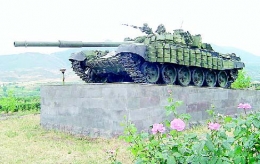With Nagorno-Karabakh, as with any long-standing political conflict, diametrically opposed viewpoints exist on its origins and escalation.
Visit the website of Azerbaijan’s Ministry of Foreign Affairs and an icon on the screen’s right grabs the attention, such is its starkness. It features an outline of Azerbaijan, as computer-generated fire-fumes emanate from the Nagorno-Karabakh region in the southwest. The text ‘ARMENIAN AGGRESSION! Towards Azerbaijan’ accompanies it, and leaves the viewer in little doubt as to the troubled relationship between these Caucasus neighbours.
Armenia’s corresponding ministry site also carries an icon – although less dramatically imaged – which is labelled ‘KARABAKH CONFLICT’.
Both ministries claim to have right on their site, and both countries and their peoples have suffered greatly from the conflict, not least those in Nagorno-Karabakh itself.
Today, the region is technically part of Azerbaijan, but is self-governed under the auspices of the Nagorno-Karabakh Republic. Armen-ians have comprised an ab-solute demographic majority in Nagorno-Karabakh since at least the early Middle Ages
In 1924, the Soviet Union – of which modern-day Armenia and Azerbaijan were then a part – created the Nagorno-Karabakh Autonomous Region within Azerbaijan, even though the population in the area was almost entirely Armenian. As the Azerbaijani population grew, the Armenians claimed discrimination, and tensions mounted on both sides.
By the late 1980s, these frictions had exploded into a full-on conflict. As violence increased, the ethnic Azeri (Azerbaijani) population fled the region, while ethnic Armenians were forced to escape from other parts of Azerbaijan.
A declaration of war never emanated from either Armenia or Azerbaijan, but large-scale combat took place between Azerbaijani and ethnic Armenian forces. The ethnic Armenians won out, and occupied some of Azerbaijani territory outside Karabakh, which acted as a buffer zone linking it with Armenia.
In 1994, a Russian-brokered ceasefire was signed, leaving the region under de facto ethnic Armenian control. It also left areas of Azeri territory around the enclave in Armenian hands.
More than 30,000 people have lost their lives since the eruption of tensions, and more than one million Armenians and Azeris have had to flee their homes.
Russia, France and the US co-chair the OSCE’s Minsk Group, which has been attempting to broker an end to the dispute for over a decade. Last November, both the Armenian and Azeri governments pledged to increase their efforts towards a peaceful solution.
– Catherine Reilly












